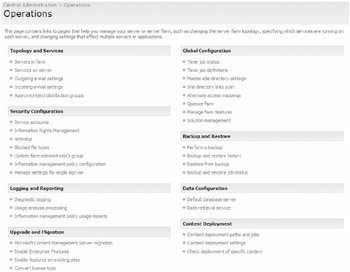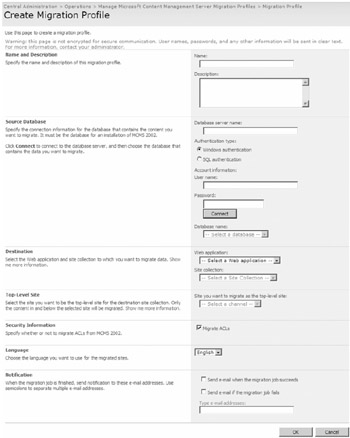SharePoint Server 2007 Content Migration
The migration of content from a Content Management Server Web site to SharePoint Server 2007 is handled by the creation of migration profiles in SharePoint's Central Administration Web site or by using the SharePoint object model. Migration profiles contain all the information required to import content from a Content Management Server Web site to a SharePoint Server 2007 WCM Web site such as the Content Management Server Content Repository source database, the target SharePoint Server 2007 WCM site collection, user and system security credentials, and an e-mail address (or addresses) to notify administrators of a successful or failed execution of the migration profile.
When a migration profile is executed, it first runs an analysis job of the content being migrated. If the migration profile analysis stage identifies any errors that would prohibit the execution of the profile, such as duplicate Content Management Server template names, it logs the errors that require resolution prior to the execution of the migration profile.
Creating Migration Profiles
The creation of a migration profile requires access to the Content Management Server 2002 database. This database contains the content to be migrated and a Web application containing a site collection created using the Blank Site template to import the Content Management Server 2002 migrated content into. If an empty Web application does not exist, you must create it prior to creating a migration profile.
| More Info | For instructions on how to creating a new Web application and site collection, see Chapter 7, "Application Management and Configuration." |
Migration profiles are created in SharePoint's Central Administration Web site. To create a migration profile, complete the following steps:
-
On the Central Administration Home page, select the Operations tab.
-
On the Operations page, in the Upgrade And Migration section, select Microsoft Content Management Server Migration, shown in Figure 22-2.
-
On the Manage Microsoft Content Management Server Migration Profiles page, select New Migration Profile.
-
On the Create Migration Profile page (shown in Figure 22-3), enter the following information:
q
Name And Description These fields are used to help distinguish this migration profile from others used in the future. None of the information here is used in the actual migration.
q
Source Database Enter the necessary information for SharePoint Server 2007 to connect to the Content Management Server 2002 database containing the content to be migrated.
q
Destination Select a destination Web application and site collection to migrate the Content Management Server 2002 data to.
q
Top-Level Site Select the top-level channel from within the Content Management Server 2002 Content Repository that will be the top-level site for the destination site collection.
q
Security Information Select the Migrate ACLs check box to migrate the access control lists from Content Management Server 2002.
q
Language Select the language to use for the migrated sites.
q
Notification Select the Send E-mail When The Migration Job Succeeds check box to be notified when the migration profile job completes with a successful migration, or select the Send E-mail If The Migration Job Fails check box to be notified if there are any failures in the execution of the migration profile. Finally, enter an e-mail address to send notifications to if either of the previous options are selected.

Figure 22-2: Microsoft Content Management Server Migration link

Figure 22-3: Create Migration Profile page
Running Content Migration Jobs
Once you have created a migration profile, you can execute an analysis to check for any issues prior to running the migration process. To analyze a migration profile, on the Manage Microsoft Content Migration Server Migration Profiles page, select the name of an existing migration profile and select Analyze from the menu.
The analysis initializes the migration profile and then runs a premigration analysis process. At the completion of the analysis process, you can select the name of a migration profile to display a drop-down menu of actions, select View History from the list of available actions, and finally select one of the migration history entries on the Migration History page. Each migration history reports the duration of the migration job and detailed errors and warnings encountered during the analysis.
| Note | If any errors are reported by the migration profile premigration analysis job, administrators and developers should address these issues prior to executing the migration profile. |
After you have executed a migration profile premigration analysis job and resolved any issues, you can schedule and execute the migration job. To execute a migration profile, on the Manage Microsoft Content Management Server Migration Profiles page, select the name of an existing migration profile and then select Run from the menu.
SharePoint immediately triggers the execution of the migration profile job. To determine the status of a migration profile job, refresh the Manage Microsoft Content Management Server Migration Profiles page. Once the job is complete, the Status column displays Succeeded to indicate a successful migration.
EAN: 2147483647
Pages: 299